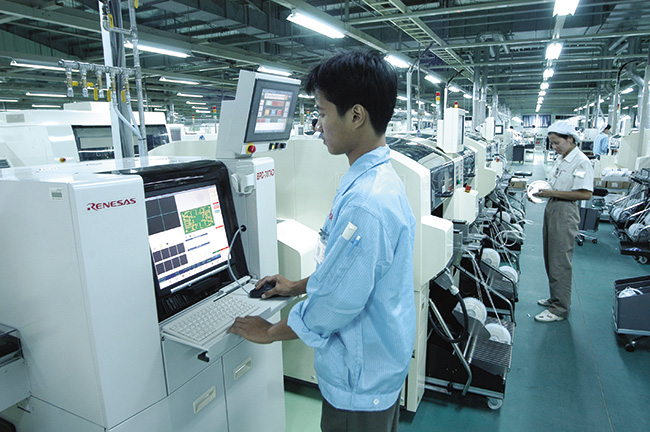Investing in HR for future growth
 |
| To attract and retain talents is the task that needs the combination of both science and art Photo: Le Toan |
Overall, AEC integration paves the way for Vietnamese businesses to access ASEAN’s market of more than 600 million people, to establish trade relations with potential partners overseas, and to grasp new technology. Economic integration will also create more jobs domestically, especially in sectors such as agriculture, logistics, information and technology, and tourism services.
Six months after the AEC implementation, it is clear that a wider range of opportunities have been offered to Vietnamese labourers. However, the main beneficiaries are unskilled workers and young labourers with little work experience. Since the supply of management-level personnel is still insufficient to meet local demand, the cross-border movement of senior personnel from Vietnam to other ASEAN countries remains insignificant.
There are only a small number of senior personnel who are capable of entering foreign labour markets to gain experience, mainly due to the human resource policies of some multinational companies.
Vietnamese enterprises have now become more confident in taking advantage of opportunities brought about by AEC. They are gradually focusing on investing and expanding capacity in order to create a solid foundation, form confidence and equip enterprise managers with integrative thinking.
For Vietnamese enterprises aiming to become a global company, there is a growth trend of sending personnel overseas for training, market exploration and partnership development. Besides, recruiting foreign personnel to managing positions requiring professional skills is also reported at these companies.
Such movements will help firms access modern working styles with clear vision and effective strategies. Also, it will boost the competitiveness in terms of productivity amongst the company staff.
Due to the increased awareness over the importance of human resources to business competitiveness, Vietnamese enterprises are rushing to invest more in personnel strategies, focusing on two key components, working environment and training, to develop skills and competency for employees.
Regarding the working environment, businesses are both upgrading infrastructure and creating an open and friendly atmosphere to help increasing their staff’s effectiveness.
With training activities we can form planning programmes and implement specific activities at all personnel levels and departments.
Vietnamese enterprises have become more active in expanding their business ranges to other countries, leading to a higher number of representative offices and branches overseas and also a higher demand for senior personnel. Recruiting indigenous staff working for overseas-based offices can be seen as another initiative in human resources (HR) management. This is advisable due to the fact that transferring key personnel from Vietnam to offices overseas will leave holes in the companies’ managing structure and also requires time for staff adaptation to new working places.
Enterprises now consider HR development as an investment for their own future growth. HR development, in addition, is determined as a key driver for the firms’ development amid fierce integration challenges.
To welcome foreign talent, a professional working environment is expected. Besides, it remains a challenge with policies relating to wages and the welfare of local and foreign labourers.
Modern HR management needs to be scientific in its application, should utilise international methods and involve a professional department responsible for all related activities. The harmony between emotional and scientific factors will help Vietnamese enterprises retain employees.
Foreign enterprises build well-designed HR strategies with a specific agenda in line with their overall business plan. In addition, their working management systems include effective tools to measure staff’s performance coupled with transparent criteria for promotion policies, however, many local enterprises have yet to pay attention to these factors.
While the business sector is already on track to accelerate its integration into the regional economic community, it seems that the domestic workforce has yet to face these challenges. However, enormous challenges will arise when multinational resources began to penetrate the Vietnam market, especially in areas with specific expertise requirements.
Local labourers will face fierce competition from their peers in developed countries, who are familiar with advanced technologies and standards. Hence, Vietnamese workers should always endeavor to improve their knowledge and skills to catch up with integration demands.
It is undeniable that AEC has certain impacts on both Vietnamese enterprises and labourers, in terms of thinking, mindset and actions. Firms need to view human resources as the key business driver, which would lead to wise investment in improving working environments and training activities.
To attract and retain talents is the task that needs the combination of both science and art, and it is the responsibility of not only human resources department but also managers of other departments, as well as the board of directors. Co-operation between levels and fields of management as such is crucial to ensure the sustainable development of any firm.
By Talentnet Corporation analysts
What the stars mean:
★ Poor ★ ★ Promising ★★★ Good ★★★★ Very good ★★★★★ Exceptional
Latest News
More News
- Global partnerships key to Vietnam’s IFC development (December 26, 2025 | 16:18)
- Vingroup pulls out of bid to invest in North-South high-speed railway (December 26, 2025 | 11:42)
- Strengthening supply chains through trade promotions and customs reform (December 24, 2025 | 14:00)
- PM orders investment model for North–South high-speed rail (December 22, 2025 | 17:43)
- LS Eco Energy to invest in Vietnam rare earth sector (December 22, 2025 | 17:31)
- Government moves to establish International Financial Centre (December 21, 2025 | 21:00)
- Vietnam's IFC to target global investment flows (December 21, 2025 | 18:00)
- Two national hospitals expand capacity with new facilities (December 20, 2025 | 09:00)
- Ha Tinh breaks ground on major Vingroup industrial and energy projects (December 19, 2025 | 18:24)
- EVN launches major power infrastructure projects nationwide (December 19, 2025 | 18:17)

















 Mobile Version
Mobile Version